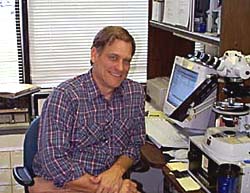Curator's Comments
by Gary Lofgren
NASA JSC
 Just before Christmas I agreed to take on the task of Lunar Sample Curator. My association with lunar samples goes back to when, as fledgling scientist caught up in the excitement the Apollo 11 rocks, I was asked to prepare the samples for allocation that required special cutting. Curtis Bauman, working with Jerry Wasserburg had designed and built a wire saw that would cut samples dry with minimal contamination. I proceeded to do 3 weeks of sawing for the initial round of Apollo 11 allocations. That saw, by the way, is still in use and a few others have been built. I then spent many years studying the crystallization properties of lunar basalts and impact melts before I moved on to similar studies on meteoritic materials. My current research emphasis remains on meteorites, but I retain a keen interest in the lunar samples and I am pleased to be a part of their continued preservation and ongoing distribution for study.
Just before Christmas I agreed to take on the task of Lunar Sample Curator. My association with lunar samples goes back to when, as fledgling scientist caught up in the excitement the Apollo 11 rocks, I was asked to prepare the samples for allocation that required special cutting. Curtis Bauman, working with Jerry Wasserburg had designed and built a wire saw that would cut samples dry with minimal contamination. I proceeded to do 3 weeks of sawing for the initial round of Apollo 11 allocations. That saw, by the way, is still in use and a few others have been built. I then spent many years studying the crystallization properties of lunar basalts and impact melts before I moved on to similar studies on meteoritic materials. My current research emphasis remains on meteorites, but I retain a keen interest in the lunar samples and I am pleased to be a part of their continued preservation and ongoing distribution for study.
My responsibilities are more limited than previous occupants of this position. My primary task will be to facilitate the allocation of lunar samples for scientific studies. I will work with CAPTEM to insure the samples continue to be used for well founded objectives and I will assist investigators in securing samples that fulfill their needs. I have inherited a great crew of devoted individuals who have participated in the process for many years and I know I can count on them to continue this process without interruption. I will team up with the present meteorite and cosmic dust curators and with the yet to be hired astromaterials and administrative curators to continue to provide NASA with first class extraterrestrial sample curation.
There continues to be a significant interest in lunar samples and investigators continue to make significant additions to our knowledge of the Moon. Most recently, e.g., Alex Halliday’s research group at Michigan used a newly developed short-lived hafnium-tungsten chronometer to further delve into the early history of the earth and the Moon that will set off some interesting discussions. See their article in Science, Nov. 7, 1997 issue, vol. 278, 1098-1103.
We are entering a new, exciting era. We are returning to the Moon for a new round of data gathering. I anticipate that the Prospector mission will generate a renewed interest in the sample collection. Brad Jolliff (see article in this newsletter), outlines a CAPTEM initiative that will focus on producing a much better correlation between lunar surface materials and the remotely collected data from the current Prospector mission and the recent Clementine mission.
Feel free to contact me at any time by email, letter, whatever!
 Just before Christmas I agreed to take on the task of Lunar Sample Curator. My association with lunar samples goes back to when, as fledgling scientist caught up in the excitement the Apollo 11 rocks, I was asked to prepare the samples for allocation that required special cutting. Curtis Bauman, working with Jerry Wasserburg had designed and built a wire saw that would cut samples dry with minimal contamination. I proceeded to do 3 weeks of sawing for the initial round of Apollo 11 allocations. That saw, by the way, is still in use and a few others have been built. I then spent many years studying the crystallization properties of lunar basalts and impact melts before I moved on to similar studies on meteoritic materials. My current research emphasis remains on meteorites, but I retain a keen interest in the lunar samples and I am pleased to be a part of their continued preservation and ongoing distribution for study.
Just before Christmas I agreed to take on the task of Lunar Sample Curator. My association with lunar samples goes back to when, as fledgling scientist caught up in the excitement the Apollo 11 rocks, I was asked to prepare the samples for allocation that required special cutting. Curtis Bauman, working with Jerry Wasserburg had designed and built a wire saw that would cut samples dry with minimal contamination. I proceeded to do 3 weeks of sawing for the initial round of Apollo 11 allocations. That saw, by the way, is still in use and a few others have been built. I then spent many years studying the crystallization properties of lunar basalts and impact melts before I moved on to similar studies on meteoritic materials. My current research emphasis remains on meteorites, but I retain a keen interest in the lunar samples and I am pleased to be a part of their continued preservation and ongoing distribution for study.